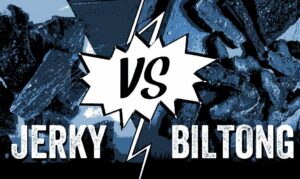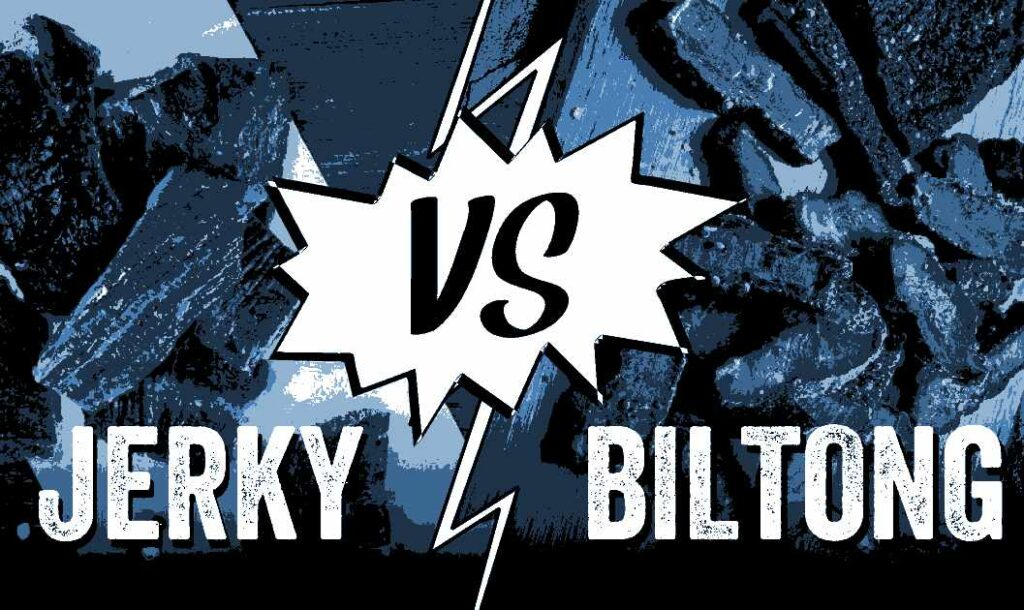How is beef biltong different from beef jerky?
Snack cravings have increased dramatically in recent years. Indeed, the healthy snack business is expected to rise by a whopping $32 billion in the coming five years. Let’s talk about the marketing of food.
Check out our guide on ” What Is Biltong ” for more information.
However, deciding where to begin can be difficult when there is such a wide variety of food to choose from. It might be difficult to tell the difference between something that appears to be healthy but is actually unhealthy. In terms of flavour, how will it differ from taking a large bite of dirt?? Those energy balls have our attention.
In this essay, we’ll go further into the meat snacks known as biltong, a snack you can always count on. You will know exactly what to pick up the next time you’re in the snack aisle since we’ll show you how it varies from beef jerky. Want to know what to cook? Check out our biltong recipe section.
What is Jerky?
Traditionally, jerky has been produced using salt and a variety of African spices and is a traditional cooked and dehydrated meat snack. As a result, the meat can remain on the shelves for a long period of time because it has been dehydrated.
What is Biltong?
Biltong is a cured meat snack resembling jerky. There are a slew of other meats that you may use instead of beef, including chicken, game, and even ostrich meat, if you’re lucky enough to find it. Vinegar, salt, coriander and black pepper are some of the traditional cures used. Jerky sounds like the same thing, doesn’t it? They are, in fact, two very distinct animals. Visit our biltong definition page for more information.

Biltong vs Jerky – The Taste
If you want to know the difference between jerky and biltong, go no further than the taste. Obviously, this is the most crucial thing we can all agree on.
If you’ve ever eaten jerky, you’re familiar with its dry, smoky taste. Biltong-makers, on the other hand, marinate the meat in a mixture of vinegar and hot, pungent spices throughout the process. As a result, the meat is juicier since it has a higher percentage of fat. Because jerky is lower in fat, it might be drier (and tougher on the teeth).
Inquiring minds want to know, “How much fat?” Never fear. Biltong isn’t always prepared using fatty beef, but it’s up to the maker to decide. The chewier and more unctuous the biltong, the higher the fat content, while the drier the biltong, the lower the fat content. It’s everything out there for you to choose from these days.
With that being said, both treats are utterly succulent. Even though they taste so different, they’re both delicious. Even after just one bite, you’d be able to tell the difference. We’d be lying if we said one was better than the other – after all, taste is a very subjective thing.
Biltong vs Jerky – The Texture
It’s clear that biltong and jerky are distinct in flavor. However, what about the texture? Biltong meat, in its simplest form, is a dehydrated steak. This means that there is a wide range of textures available, from hard, chewy pieces (like well-done beef) to moist types (like steamed broccoli) (rare steak).
A dehydrator or oven is used to make jerky. Is this what you came up with? A snack that is drier. There’s just one kind of jerky on the market, and that’s the rough, chewy kind. Which is a favourite of many.

Biltong vs Jerky – Production process
By now, you’ve probably figured out that the methods used to make biltong and jerky are diametrically opposed. After slicing the strips of meat, jerky manufacturers roast them in an oven or dry them on a rack in a dehydrator for as long as 12 hours. As a result, the meat is quite tough. To enhance the flavor and tenderize the meat, it is common practice to marinate the chunks in a salty-sweet marinade after cooking.
Biltong is often marinated overnight in a spice- and vinegar-based marinade. In fact, the more time that passes, the better it will be. All that matters after curing is the drying process (no heat necessary). After then, it’s time to cut it up. To your liking, either thin or thick.
Difference #4 – Ingredients
Ingredients are a key one. Jerky and biltong are both created with a variety of spices, but the ingredients are never the same. When it comes to producing biltong, vinegar is the star of the show. Actually, it’s essential for preserving meat in any way. Clove, allspice, pepper and coriander are the most commonly used spices in the drying process, along with a generous amount of salt. However, you won’t discover vinegar in the jerky making process. In order to enhance the flavor of the meat, flavouring chemicals and high levels of salt/sugar are used in the cooking process.
So there you have it – detailed comparison between beef jerky and biltong. Both are irresistible treats, which is why they’re growing in popularity as more people discover them. However, we don’t want the two to be mixed up. Now that you’ve mastered the subject, you’re able to discern the tiniest distinctions between the two, down to the methods of manufacturing and the final flavor and texture. After one mouthful, you’ll be able to identify one is which even though they appear same. We believe that the best way to decide between biltong and jerky is to try them both. Jerky not your thing? That doesn’t mean that biltong isn’t going to become your new favourite snack.
